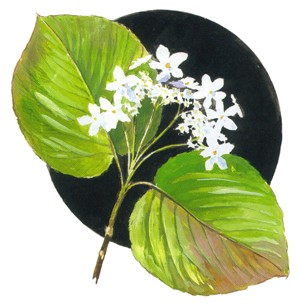
Hikers in the mountains of the Northeast spend most of their time in the forest, emerging above the timberline for the occasional long view, then plunging back again into the greenery. The forest is a fascinating place, an ecosystem filled with plant species that can, if given the attention they deserve, elicit hours of interest and wonder.
The humble hobblebush (Viburnum lantanoides) is one such plant, a companion to hikers year-round. You can be reasonably sure of encountering it on just about any hike through the forests of northern New England.
Hobblebush is a scraggly, sprawling shrub that favors moist deciduous forests up to about 3,000 feet in elevation. It is rarely more than five feet in height, with large, round, slightly pointed heart-shaped leaves, and a half-dozen folk names that indicate it has long been a curse to anyone trying to bushwhack through the woods: hobblebush (its sprawling branches hobble you); witch-hobble (it even hobbles witches!); tangle-legs, and so on.
Actually, the “witch” in witch-hobble doesn’t refer to supernatural beings. It’s a word descended from the Middle English word “withy,” which means a strong, flexible switch-like branch. It’s the same “witch” as in “witch hazel,” another withy or switch-like shrub.
Some hunters refer to the plant as “moosebush,” as in winter the leathery brown buds look like moose ears. Some loggers used to refer to the plant as “she-moosewood,” in the mistaken belief that it was the female form of the striped maple (Acer pensylvanicum), another understory plant, but related in no way to hobblebush. Striped maple is sometimes referred to as “moose maple,” and in fact, moose feed eagerly on both plants.
In any case, hobblebush can be a witch-like impediment to anyone who hikes cross-country through the mountains of New England. Its branches can be four feet in length or longer, and they are both strong and supple. They have the ability to root themselves from the tip, wherever those tips touch the ground, thus creating wicket-like snarls of branches. As a result, they arc throughout the forest understory, quietly growing into devilish thickets guaranteed to impede the progress of the unmindful.
The plant has no commercial uses and therefore should qualify only as a nuisance to human beings. But there is another side to the hobblebush. Especially in May, the hobblebush is undeniably beautiful.
The plant leafs out in early spring and blossoms in mid-to-late May, about the same time that painted trilliums, trout lilies, and Canada mayflower can be found on the forest floor. Hobblebush blossoms spectacularly, extending bright white clusters of blossoms, sometimes six or eight inches across, out on the ends of its long, supple branches.
The blossom clusters are complex, with the central portion composed of tiny waxy-white flowers, complete with stamen and pistils, bunched tightly together in a snowy mass. They are surrounded by much larger five-petaled flowers, about an inch across, that are also brilliant white, but are sterile – they have no stamens or pistils and thus do not produce fruit or seeds. It is surmised that their function is to attract insects to pollinate the inner cluster of fertile flowers.
There are many mountain trails in Vermont, New Hampshire, and Maine that are replete with stands of hobblebush, especially at lower elevations. This time of year, hikers who time their outing right can climb through blossoms and descend through blossoms – usually batting clouds of hungry biting insects out of the way. Every glimpse of beauty has its price.
Nevertheless, to walk one of these trails at dusk, surrounded by the humble shrub’s fresh green foliage and clustered white blossoms, is to know what springtime in the mountains really means.As the season progresses, the clusters of white blossoms will transform into clusters of small green berries, which gradually ripen over the summer and fall – first to pink, then bright red, and finally black. The hobblebush leaves, so fresh and bright green in May, gradually darken and become mottled red and purple as summer turns to autumn.
As the season progresses, the clusters of white blossoms will transform into clusters of small green berries, which gradually ripen over the summer and fall – first to pink, then bright red, and finally black. The hobblebush leaves, so fresh and bright green in May, gradually darken and become mottled red and purple as summer turns to autumn.


Discussion *